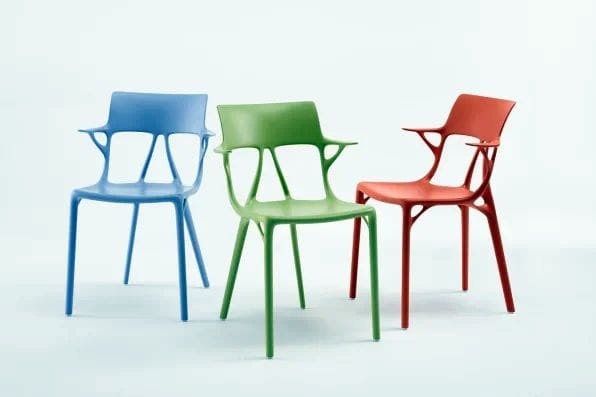![Generatively designed chairs [Source: Autodesk]](https://fabbaloo.com/wp-content/uploads/2020/05/image-asset_img_5eb0990cec903.jpg)
A report on Fast Company illustrates that there’s more than one way to do generative design.
This story, written by Katharine Schwab, tells of how UK-based high-end furniture and decor distributor Kartell intends on selling a generatively designed chair this summer. The chair will take its place among other astonishingly beautiful items for sale at that online store.
Schwab describes this as the ”first commercial product made using generative design”.
So what, you must be thinking; generatively designed 3D prints have been around for quite a while, and are commonly used in industry. This is especially true in the aerospace industry, where today many components use generative design approaches to minimize the weight of the parts.
Typically a part is conventionally designed and then undergoes a finite element analysis, which shows the portions of the part that actually undergo mechanical stress and those portions that do not. The portions that are not mechanically relevant to the part’s usage are simply removed.
This often leaves us with a rather bizarrely shaped part that has curious voids and a possibly foam-like structure. Parts of this design are marvelous to look at, and usually impossible to produce using conventional manufacturing processes.
But let’s think about what was going on in this scenario: the AI in this case was instructed to seek a goal of producing a mechanically sound part within some design constraints. It did so magnificently, but is the resulting part something you’d actually want to look at?
This is the crux of the issue that faced Kartell, who collaborated with noted designer Philippe Starck and Autodesk.
The concern was, would it be possible to provide design constraints to the AI that would cause it to generate a beautiful AND functional chair? That is not the typical usage scenario for generative design in today’s industrial world.
Somehow, the partners were able to coerce a suitable design from the AI, which was then placed into production for sale. As I understand it, injection molding was used to manufacture the final chairs, rather than 3D printing. However, a design is a design and these techniques could certainly be used with 3D printing as well.
Evidently the team had some challenges in persuading the AI to produce the chair, as their only input to the system was design constraints that are typically used for engineering aspects. But this may not be the case for much longer. Schwab explains:
“The software that Starck and Autodesk’s designers worked with isn’t commercially available, and while it’s still limited in terms of the constraints it can work with–primarily, technical ones–a platform that could control aesthetic principles as well has huge possibilities for Autodesk. The company is already working on an experimental algorithm called Deep Style that can mimic a particular company’s industrial design ethos. The goal is for the computer to generate designs that are aesthetically pleasing or closer to a company’s brand identity, even if they’re less functional.”
If Autodesk succeeds in this effort it could be a game changer that might open up all manner of fantastic possibilities for amazing consumer product designs in the future.
I’m hoping they succeed, and I’m sure all 3D printer manufacturers do too.
Via Fast Company











A manufacturing-as-a-service company has developed a way to 3D print continuous carbon fiber in a production setting.